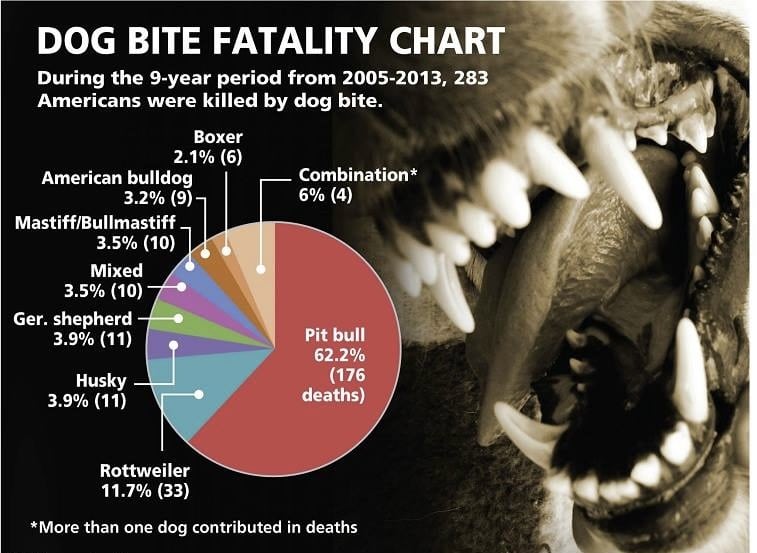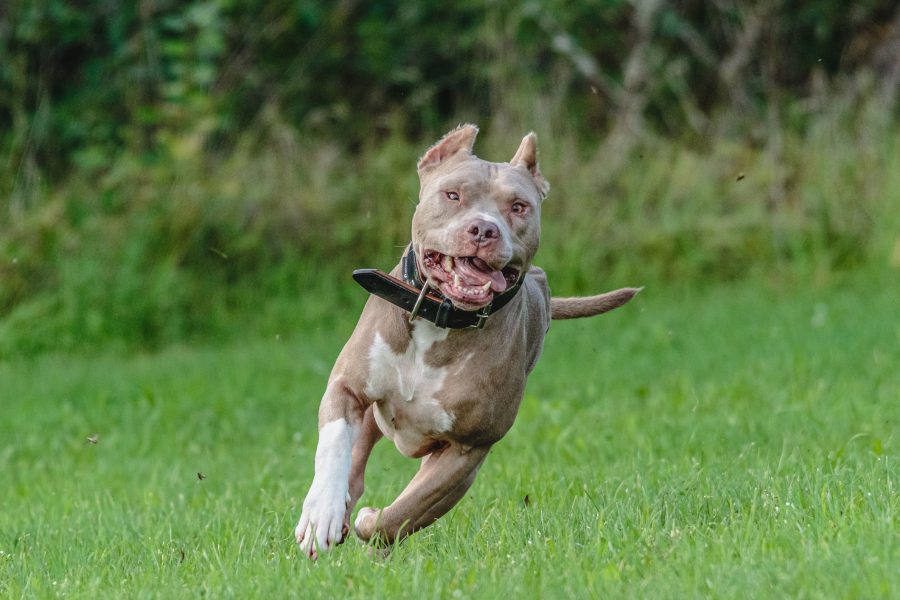Pit Bull Attacks Statistics: Bite Count, Facts, and Deaths
Pit Bull attacks have been a heated debate and controversial topic for years. These discussions are often fueled by emotional anecdotes and sensationalized stories, making it crucial to delve into the cold, hard facts. In this data-driven exploration, we aim to shed light on the actual pit bull attack statistics.
Thousands of dog-related injuries occur yearly, with pit bulls frequently under the spotlight. But as with any complex issue, a clear understanding of the problem is paramount.
Are pit bulls inherently more dangerous than other breeds, or do misconceptions and biases cloud our judgment?
Attack Statistics of The Pit Bull

In the past five years, the average Eruscide rate of a pit bull was 53%. Eruscide refers to a dog attacking its owner or members of the owner’s family. Pit bulls are not safe for homes with toddlers or young children as they account for top canine killers of children. As per the 2018 pit bull attack statistics, pit bulls killed 249 American children.
Therefore, to mitigate the risk of such attacks, the owners must follow all the safety measures and guidelines regarding a pit bull.
We will explore the statistics of pit bull attacks and the circumstances surrounding them to discern patterns that can inform the public and policymakers. Our mission is not only to present the data but also to challenge prevalent myths and stereotypes, replacing them with a well-informed discourse.
1. Attack Numbers
This section dives deep into the most recent statistics on pit bull attacks in the United States, providing an illuminating perspective on the scope and trends surrounding these incidents. Pit Bull attacks, like any other social issue, are best understood when we begin with the basics: the numbers. According to the most recent data available, pit bulls have killed 515 Americans since 1980.
Additionally, they have also attacked and injured 441 Americans to death since 1998. Due to such violent attacks and their dangerous nature, the U.S. Army banned pit bulls from military housing. However, it is essential to emphasize that this does not inherently make them more dangerous than other breeds.
The sheer number of pit bulls in the country naturally increases their representation in bite incidents. It is important to note that there are around 18 million pit bull-type dogs and their mixes in the U.S. currently! They contribute to the 6% of the total dog population of the country.
Trends over the years show that while pit bull attacks have occurred, they don’t necessarily follow a linear path. Incidents can fluctuate, influenced by factors such as population density, legislation, and public awareness. Some years see a rise in reported pit bull attack statistics, while others show a decline.
2. Geographical Distribution of Attacks
Understanding where these incidents occur is vital for developing targeted prevention strategies. The geographic distribution of statistics of pit bull attacks is not uniform across the United States. Certain regions and cities have higher incidences than others. The top three states with the most fatal pit bull attacks are Texas, California, and Georgia.
Various factors, including population density, climate, and the prevalence of pit bulls in those areas, influence this distribution. In urban areas with more pit bulls, there may be a correspondingly higher number of reported attacks—this complex interplay of human factors, including pet ownership practices, socialization, and training.
3. Significant Changes and Patterns in Data
Analyzing the pit bull attack statistics also reveals intriguing patterns and changes. For instance, some studies suggest that unneutered or unspayed dogs are more likely to be involved in attacks. This highlights the importance of responsible pet ownership practices like spaying and neutering.
Additionally, it is crucial to consider the role of owner responsibility and socialization. Many pit bull attacks are linked to improper training or mistreatment. Responsible pit bull owners who prioritize training, socialization, and proper can significantly reduce the likelihood of their dogs being involved in attacks.
Patterns also emerge when considering the circumstances of attacks. Many occur in the home or involve familiar situations, emphasizing the need for education and awareness even among those who interact with these dogs regularly. The number surrounding pit bull attacks provides a multifaceted view of why pit bulls attack.
While there are pit bull incidents, it is essential to interpret this data carefully. Rather than demonizing the breed, a holistic approach that addresses factors such as responsible ownership, training, and public awareness is key to reducing the frequency of these unfortunate events.
Bite Count and Severity

The bite count in pit bull attack incidents is a crucial metric that sheds light on the range of severity. It is important to understand that not all pit bulls are the same. Some may result in minor injuries, while others can be life-threatening.
According to available statistics, pit bulls are responsible for 22.5% of dog bites. From 2013 to 2021, pit bulls contributed to the most dog bites in 20 states. Thus, pit bulls account for a significant portion of reported dog bites.
However, it is essential to clarify that not all pit bull bites are severe. Most pit bull bites fall into the category of minor injuries, such as scratches and minor puncture wounds that don’t require hospitalization.
Differentiating Between Minor and Severe Bites

To gain a more comprehensive understanding of pit bull attack statistics, it is crucial to differentiate between minor and severe bites. Severe bites typically involve extensive tissue damage, multiple puncture wounds, and a higher risk of infection. These bites often require immediate medical attention, including surgery and wound care.
Minor bites, on the other hand, may result in minimal injury, with wounds that can be managed with basic first aid. While any dog should be taken seriously, most pit bull bites fall into minor and not severe categories.
Factors Contributing to the Bite Severity of The Pit Bull Bite
Several factors contribute to the severity of pit bull bites, and understanding these factors is key to developing effective prevention strategies. Some of these factors include:
- Owner Responsibility: The level of responsibility exhibited by the dog’s owner plays a significant role. Well-trained and socialized pit bulls are less likely to engage in aggressive behaviors.
- Socialization: Pit bulls usually score above 85% on temperament tests, proving that they are not as vicious and violent as one usually presumes. Therefore, properly socialized pit bulls are more likely to interact positively with humans and other animals. Lack of socialization can lead to fear-based aggression.
- Training: Adequate training and obedience can mitigate the risk of a pit bull reacting aggressively in various situations.
- Supervision: The level of supervision provided when pit bulls are around children or unfamiliar individuals is critical. Lack of supervision can result in fatal accidents.
- Spaying and Neutering: Unneutered or unspayed dogs may be more prone to aggression, which can influence the severity of bites.
By exploring these factors, we gain insights into the complexity of pit bull bite incidents. The data suggests that responsible ownership practices, proper socialization, and training are pivotal in reducing the severity of bites.
Deaths from Pit Bull Attack

While most pit bull attacks result in injuries, it is essential to examine the death counts. This section shares data on fatalities resulting from pit bull attacks while examining the circumstances surrounding these tragic incidents and comparing pit bull-related deaths to those caused by other dog breeds.
1. Death Count
Fatalities resulting from pit bull attacks are, fortunately, relatively rare in comparison to the overall number of pit bull bites. However, they are undeniably the most devastating aspect of the issue. Understanding these fatalities is crucial for comprehending the true scope of why pit bulls attack and identifying areas of prevention.
According to available statistics from 2005 to 2017, pit bulls have been responsible for 66% of dog-related fatalities in the United States. They were the cause of death for 284 Americans during this period. These incidents often garner significant media attention and can reinforce negative stereotypes about the breed.
Approximately 25% of the US citizens think negatively about the pit bulls. Additionally, around 1 million pit bulls are euthanized yearly due to negative prejudices and stereotypes. While the loss of life is a tragedy, it’s essential to emphasize that not all pit bulls exhibit aggressive behavior, leading to fatalities.
2. Circumstances Surrounding Fatal Incidents
Examining the circumstances surrounding fatal pit bull attacks reveals important insights for pit bull attack statistics. These incidents often occur in familiar settings, such as the victims’s home or the home of a friend or family member. Sometimes, the victim may have had a close relationship with the dog involved.
Understanding these details highlights the role of owner responsibility and proper supervision in preventing such tragedies. Additionally, it’s important to consider factors such as the dog’s history, training, and socialization when analyzing fatal incidents. Many fatal attacks involve pit bulls with a history of aggression or neglect, underscoring the importance of responsible ownership and early intervention.
3. Comparing Pit Bull-Related Deaths
To gain a more comprehensive perspective on pit bull attack statistics, it’s essential to compare pit bull-related deaths to those caused by other dogs. While pit bulls have been involved in some fatal incidents, they are not the leading breed responsible for such tragedies. In fact, various other breeds, including larger breeds like Rottweilers and German Shepherds, have also been implicated in fatal attacks.
This comparison highlights the need to address dog-related fatalities as a broader issue rather than singling out specific breeds. Responsible ownership practices, proper training, and education about dog behavior are critical components for lowering the pit bull attack statistics.
Cost of Dog Bite Injuries and Insurance

Dog bite injuries, regardless of the breed involved, can have significant financial implications. It is important to know the economic aspect of dog bite injuries, including medical expenses and insurance claims. Dog bite injuries can result in substantial medical expenses, including emergency room visits, surgeries, hospital stays, and follow-up treatments.
Homeowners and renters insurance policies often provide coverage for dog bite incidents. However, the coverage terms and conditions vary widely between insurance companies and policies.
Some insurers may have breed-specific exclusions or restrictions, while others may offer coverage regardless of the dog’s breed.
Pit Bull “Facts” That Are Totally Wrong

Due to pit bull attack statistics being high, pit bulls have been the subject of numerous myths and misconceptions. Let us debunk these misconceptions and reduce the negative stereotypes about this breed.
- Pit Bulls have locking jaws: Pit bulls do not possess special “locking” jaws. They have the same jaw structure as other dog breeds.
- Pit Bulls are naturally aggressive: There is no inherent aggression in the pit bull breed. Many pit bulls are loving and well-behaved pets.
- Pit Bulls have the highest bite force: Studies show that bite force varies among individual dogs, and pit bulls are not at the top of the list. Any scientific evidence does not support breed-specific bite force claims.
- All pit bulls are dangerous: Generalizing an entire breed based on the actions of a few is unfair and unfounded. Temperament varies widely among individual dogs, and many pit bulls are gentle and friendly.
- Pit Bulls are bred for fighting: While pit bulls are historically associated with dog fighting, most pit bulls today are bred for companionship and are not used in dog fighting.
- Pit Bulls are unpredictable: Like all dogs, pit bulls exhibit predictable behaviors when raised and trained properly. Socialized and well-trained pit bulls are not more unpredictable than other breeds.
- Pit Bulls attack without warning: Dogs typically exhibit warning signs before biting. These signs include growling, barking, and body language changes. It is crucial to recognize and respond to these signs.
- Pit bulls cannot be trusted around children: Pit bulls can be excellent family pets and are often gentle with children when properly trained and supervised.
- Pit bulls have a killer instinct: This belief is not supported by scientific evidence. Dogs do not have a ‘killer instinct.’ Aggression in dogs often results from fear or improper handling.
- Pit bulls harm their owners: Pit bulls, like all dogs, can become aggressive if mistreated or neglected. Proper care, training, and socialization are essential for any dog’s good behavior.
- Pit bulls are outlawed everywhere: While some areas have breed-specific legislation, not all places have banned pit bulls. Breed-specific bans have been challenged for their effectiveness and fairness.
- Pit bulls can not be rehabilitated: With proper training and rehabilitation, many pit bulls who have experienced neglect or mistreatment can become well-adjusted and loving pets.
In discussing pit bulls or any other breed, it is crucial to rely on accurate information and dispel myths perpetuating bias and misinformation. This will make people aware of the responsible ownership, socialization, and training needs of a dog.
Proper awareness and guidance about pit bull ownership will significantly reduce pit bull attack statistics.
Conclusion
In this article, we explored valuable insights by analyzing pit bull attack statistics, challenged prevailing misconceptions, and offered a more nuanced understanding of the complex issue of why pit bulls attack. We have learned that while pit bull attacks occur, they are not isolated to this breed alone. Responsible pet ownership, encompassing training, socialization, and proper care, is essential in preventing pit bull attacks and fatalities.
These proactive measures not only protect the community but also ensure the well-being and safety of our dear four-legged companions. Moreover, we have also debunked myths surrounding pit bulls, emphasizing that individual temperaments vary widely within the breed. Negative stereotypes and prejudices do a disservice to these dogs, many of whom are loyal, affectionate, and devoted family pets.
In concluding this analysis of pit bull attack statistics, let us underscore the significance of approaching pit bull-related issues with balance and factual information. The data shows that pit bull attacks are a piece of a larger puzzle, where responsible ownership, education, and awareness about dog behavior play pivotal roles. By fostering a well-informed and empathetic perspective, we can work together to create safer environments for both humans and dogs.







